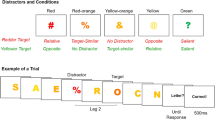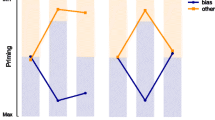Abstract
The relationship between attentional control and episodic representation was investigated in six experiments that employed a variant of the classic attentional blink paradigm. We introduced a task-irrelevant (unpredictive) color match between the first and second target stimulus in a three-stream rapid serial visual presentation task. When this match was present, the first target reliably elicited a priming benefit to the identification of the second, lateralized target. However, this was only the case when the identities of the targets did not belong to the same category (digits, letters, or symbols). When targets did belong to the same category, interference was observed instead of priming, particularly at Lag 1. Furthermore, when color was the target-defining feature, interference at Lag 1 gave way to priming at longer lags. The interference effect is attributed to partial overlap between competing episodic target representations, which affects the availability of their overlapping features for successive attentional selection in rapid serial visual presentation.








Similar content being viewed by others
References
Akyürek, E. G., Eshuis, S. A. H., Nieuwenstein, M. R., Saija, J. D., Başkent, D., & Hommel, B. (2012). Temporal target integration underlies performance at Lag 1 in the attentional blink. Journal of Experimental Psychology: Human Perception and Performance. (in press).
Akyürek, E. G., & Hommel, B. (2005). Target integration and the attentional blink. Acta Psychologica, 119, 305–314.
Akyürek, E. G., & Hommel, B. (2007). Stimulus and response priming in rapid serial visual presentation: Evidence for a dissociation. Perception & Psychophysics, 69, 1152–1161.
Akyürek, E. G., Riddell, P. M., Toffanin, P., & Hommel, B. (2007). Adaptive control of event integration: Evidence from event-related potentials. Psychophysiology, 44, 383–391.
Akyürek, E. G., Toffanin, P., & Hommel, B. (2008). Adaptive control of event integration. Journal of Experimental Psychology: Human Perception and Performance, 34, 569–577.
Balani, A. B., Soto, D., & Humphreys, G. W. (2010). Working memory and target-related distractor effects on visual search. Memory & Cognition, 38, 1058–1076.
Bargh, J. A. (1989). Conditional automaticity: Varieties of automatic influence in social perception and cognition. In J. S. Uleman & J. A. Bargh (Eds.), Unintended thought (pp. 3–51). London: Guilford Press.
Bowman, H., & Wyble, B. (2007). The simultaneous type, serial token model of temporal attention and working memory. Psychological Review, 114, 38–70.
Broadbent, D. E., & Broadbent, M. H. (1987). From detection to identification: Response to multiple targets in rapid serial visual presentation. Perception & Psychophysics, 42, 105–113.
Bundesen, C. (1990). A theory of visual attention. Psychological Review, 97, 523–547.
Chun, M. M., & Potter, M. C. (1995). A two-stage model for multiple target detection in rapid serial visual presentation. Journal of Experimental Psychology: Human Perception and Performance, 21, 109–127.
Desimone, R., & Duncan, J. (1995). Neural mechanisms of selective visual attention. Annual Review of Neuroscience, 18, 193–222.
Di Lollo, V., Kawahara, J.-I., Ghorashi, S. M. S., & Enns, J. T. (2005). The attentional blink: resource depletion or temporary loss of control? Psychological Research, 69, 191–200.
Downing, P. E. (2000). Interactions between visual working memory and selective attention. Psychological Science, 11, 467–473.
Downing, P. E., & Dodds, C. M. (2004). Competition in visual working memory for control of search. Visual Cognition, 11, 689–703.
Duncan, J. (1980). The locus of interference in the perception of simultaneous stimuli. Psychological Review, 87, 272–300.
Duncan, J., & Humphreys, G. W. (1989). Visual search and stimulus similarity. Psychological Review, 96, 433–458.
Duncan, J., Ward, R., & Shapiro, K. (1994). Direct measurement of attentional dwell time in human vision. Nature, 369, 313–315.
Folk, C. L., Leber, A. B., & Egeth, H. E. (2002). Made you blink! Contingent attentional capture produces a spatial blink. Perception & Psychophysics, 64, 741–753.
Folk, C. L., Leber, A. B., & Egeth, H. E. (2008). Top-down control settings and the attentional blink: Evidence for non-spatial attentional capture. Visual Cognition, 16, 616–642.
Folk, C. L., & Remington, R. W. (1998). Selectivity in distraction by irrelevant featural singletons: Evidence for two forms of attentional capture. Journal of Experimental Psychology: Human Perception and Performance, 24, 847–858.
Folk, C. L., Remington, R. W., & Johnston, J. C. (1992). Involuntary covert orienting is contingent on attentional control settings. Journal of Experimental Psychology: Human Perception and Performance, 18, 1030–1044.
Folk, C. L., Remington, R. W., & Wright, J. H. (1994). The structure of attentional control: Contingent attentional capture by apparent motion, abrupt onset and colour. Journal of Experimental Psychology: Human Perception and Performance, 20, 317–329.
Ghorashi, S., Spalek, T. M., Enns, J. T., & Di Lollo, V. (2009). Are spatial selection and identity extraction separable when attention is controlled endogenously? Attention, Perception, and Psychophysics, 71, 1233–1240.
Hommel, B. (2002). Responding to object files: Automatic integration of spatial information revealed by stimulus-response compatibility effects. Quarterly Journal of Experimental Psychology, 55A, 567–580.
Hommel, B. (2004). Event files: Feature binding in and across perception and action. Trends in Cognitive Sciences, 8, 494–500.
Hommel, B., & Akyürek, E. G. (2005). Lag 1 sparing in the attentional blink: Benefits and costs of integrating two events into a single episode. Quarterly Journal of Experimental Psychology, 58A, 1415–1433.
Hommel, B., Müsseler, J., Aschersleben, G., & Prinz, W. (2001). The theory of event coding (TEC): A framework for perception and action planning. Behavioral and Brain Sciences, 24, 849–878.
Jolicœur, P., & Dell’Acqua, R. (1998). The demonstration of short-term consolidation. Cognitive Psychology, 36, 138–202.
Juola, J. F., Botella, J., & Palacios, A. (2004). Task- and location-switching effects on visual attention. Perception & Psychophysics, 66, 1303–1317.
Kanwisher, N. G. (1987). Repetition blindness: Type recognition without token individuation. Cognition, 27, 117–143.
Kanwisher, N. G. (1991). Repetition blindness and illusory conjunctions: Errors in binding visual types with visual tokens. Journal of Experimental Psychology: Human Perception and Performance, 17, 404–421.
Kawahara, J.-I., Zuvic, S. M., Enns, J. T., & Di Lollo, V. (2003). Task switching mediates the attentional blink even without backward masking. Perception & Psychophysics, 65, 339–351.
Lin, P.-H., & Luck, S. J. (2009). The influence of similarity on visual working memory representations. Visual Cognition, 17, 356–372.
Logan, G. D., & Gordon, R. D. (2001). Executive control of visual attention in dual-task situations. Psychological Review, 108, 393–434.
Logie, R. H., Brockmole, J. R., & Jaswal, S. (2011). Feature binding in visual short-term memory is unaffected by task-irrelevant changes of location, shape, and color. Memory & Cognition, 39, 24–36.
Norman, D. A., & Shallice, T. (1986). Attention to action: Willed and automatic control of behavior. In R. J. Davidson, G. E. Schwartz, & D. Shapiro (Eds.), Consciousness and self-regulation (Vol. 4, pp. 1–18). New York: Plenum.
Olivers, C. N. L. (2009). What drives memory-driven attentional capture? The effects of memory type, display type, and search type. Journal of Experimental Psychology: Human Perception and Performance, 35, 1275–1291.
Olivers, C. N. L., Hilkenmeier, F., & Scharlau, I. (2011a). Prior entry explains order reversals in the attentional blink. Attention, Perception, & Psychophysics, 73, 53–67.
Olivers, C. N. L., & Meeter, M. (2008). A boost and bounce theory of temporal attention. Psychological Review, 115, 836–863.
Olivers, C. N. L., Peters, J., Houtkamp, R., & Roelfsema, P. R. (2011b). Different states in visual working memory: When it guides attention and when it does not. Trends in Cognitive Sciences, 15, 327–334.
Pashler, H., & Shiu, L.-P. (1999). Do images involuntarily trigger search? A test of Pillsbury’s hypothesis. Psychonomic Bulletin & Review, 6, 445–448.
Potter, M. C., Staub, A., & O’Connor, D. H. (2002). The time course of competition for attention: Attention is initially labile. Journal of Experimental Psychology: Human Perception and Performance, 28, 1149–1162.
Pratt, J., & Hommel, B. (2003). Symbolic control of visual attention: The role of working memory and attentional control settings. Journal of Experimental Psychology: Human Perception and Performance, 29, 835–845.
Raymond, J. E., Shapiro, K. L., & Arnell, K. M. (1992). Temporary suppression of visual processing in an RSVP task: An attentional blink? Journal of Experimental Psychology: Human Perception and Performance, 18, 849–860.
Shapiro, K. L., Driver, J., Ward, R., & Sorensen, R. E. (1997). Priming from the attentional blink: A failure to extract visual tokens but not visual types. Psychological Science, 8, 95–100.
Soto, D., Heinke, D., Humphreys, G. W., & Blanco, M. J. (2005). Early, involuntary top-down guidance of attention from working memory. Journal of Experimental Psychology: Human Perception and Performance, 31, 248–261.
Soto, D., Hodsoll, J., Rotshtein, P., & Humphreys, G. W. (2008). Automatic guidance of attention from working memory. Trends in Cognitive Sciences, 12, 342–348.
Soto, D., Humphreys, G. W., & Heinke, D. (2006). Working memory can guide pop-out search. Vision Research, 46, 1010–1018.
Stoet, G., & Hommel, B. (1999). Action planning and the temporal binding of response codes. Journal of Experimental Psychology: Human Perception and Performance, 25, 1625–1640.
Theeuwes, J. (1991). Cross-dimensional perceptual selectivity. Perception & Psychophysics, 50, 184–193.
Theeuwes, J. (1994). Stimulus-driven capture and attentional set: Selective search for color and visual abrupt onsets. Journal of Experimental Psychology: Human Perception and Performance, 20, 799–806.
Theeuwes, J., & Burger, R. (1998). Attentional control during visual search: The effect of irrelevant singletons. Journal of Experimental Psychology: Human Perception and Performance, 24, 1342–1353.
Thompson, C., Underwood, G., & Crundall, D. (2007). Previous attentional set can induce an attentional blink with task-irrelevant initial targets. Quarterly Journal of Experimental Psychology, 60, 1603–1609.
Treisman, A. (1996). The binding problem. Current Opinion in Neurobiology, 6, 171–178.
van Zoest, W., Donk, M., & Theeuwes, J. (2004). The role of stimulus-driven and goal-driven control in saccadic visual selection. Journal of Experimental Psychology: Human Perception and Performance, 30, 746–759.
Visser, T. A. W., Bischof, W. F., & Di Lollo, V. (1999). Attentional switching in spatial and non-spatial domains: Evidence from the attentional blink. Psychological Bulletin, 125, 458–469.
Waszak, F., Hommel, B., & Allport, A. (2003). Task-switching and long-term priming: Role of episodic stimulus-task bindings in task-shift costs. Cognitive Psychology, 46, 361–413.
Wolfe, J. M. (1998). Visual search. In H. Pashler (Ed.), Attention (pp. 13–73). Hove, UK: Psychology Press.
Woodman, G. F., & Luck, S. J. (2007). Do the contents of visual working memory automatically influence attentional selection during visual search? Journal of Experimental Psychology: Human Perception and Performance, 33, 363–377.
Woodman, G. F., & Vogel, E. K. (2008). Selective storage and maintenance of an object’s features in visual working memory. Psychonomic Bulletin & Review, 15, 223–229.
Wyble, B., Bowman, H., & Nieuwenstein, M. R. (2009). The attentional blink provides episodic distinctiveness: Sparing at a cost. Journal of Experimental Psychology: Human Perception and Performance, 35, 787–807.
Wyble, B., Potter, M. C., Bowman, H., & Nieuwenstein, M. R. (2011). Attentional episodes in visual perception. Journal of Experimental Psychology: General, 140, 488–505.
Yamada, Y., & Kawahara, J.-I. (2007). Dividing attention between two different categories and locations in rapid serial visual presentations. Perception & Psychophysics, 69, 1218–1229.
Acknowledgments
This research was supported by the German Research Foundation (DFG) as part of the excellence cluster “Cognition for Technical Systems” (CoTeSys), project #148. The authors would like to thank Ali Abedian-Amiri, Jelena Pobrić, Carmen de Weerd, and Lea Wicke for their help with data collection, and Brad Wyble for valuable comments on an earlier draft.
Author information
Authors and Affiliations
Corresponding author
Rights and permissions
About this article
Cite this article
Akyürek, E.G., Schubö, A. & Hommel, B. Attentional control and competition between episodic representations. Psychological Research 77, 492–507 (2013). https://doi.org/10.1007/s00426-012-0445-9
Received:
Accepted:
Published:
Issue Date:
DOI: https://doi.org/10.1007/s00426-012-0445-9




